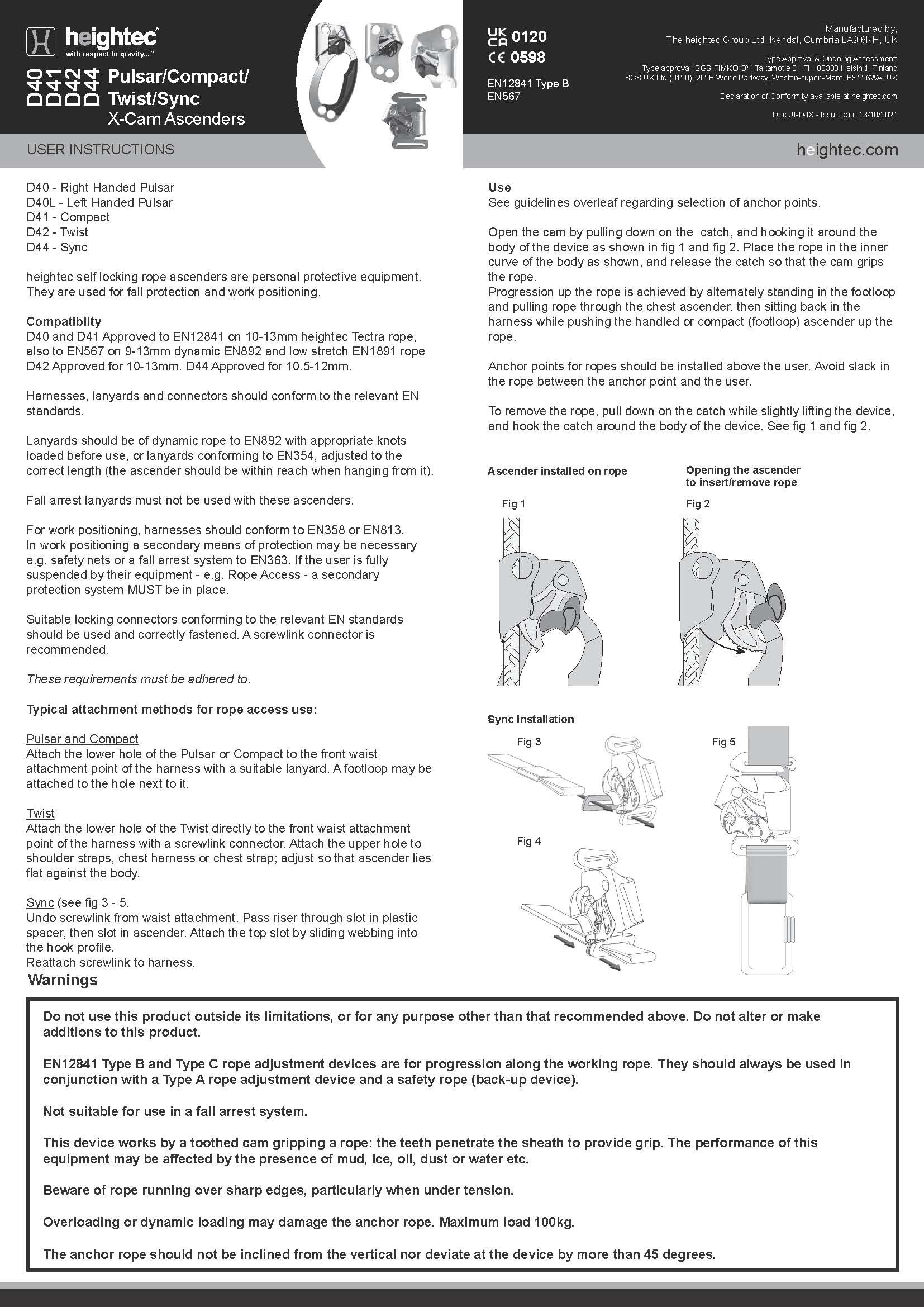Overview
Heightec once marked some of their products with the "heightec-PMI" brand for sale by PMI in the U.S.A.
[ Top
| Twist D42
| Twist D42 v. A
| Twist D42 v. B
| Return to E.C. Ascenders
]
heightec Sync D44
(#3500)
Technical Details
I acquired my heightec Sync D44 from heightec in 2022.
The heightec Sync D44 is 96 mm. tall, 75 mm. wide, 35 mm. thick, and weighs 145 g.
Like most chest ascenders,
this one is left-handed. 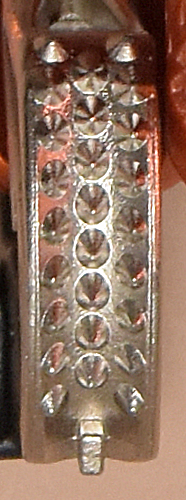 The ascender shell is a 4.0 mm. thick subrectangular orange anodized aluminum
stamping. The rope channel is formed by bending
the right side of the ascender into a U. The rope channel
is 15 mm. wide. The left
end of the shell is bent on an inclined axis to form another U.
A hole drilled through both sides of the U accepts a semi-tubular rivet.
The cam, cam spring, and a spacer washer are mounted on this rivet.
The head of the rivet is in the front, while the roll is in the
rear. The hole in the roll is nearly s deep as the shell is thick.
The pivot is centered 47 mm. from the inside of the rope
groove. There is a stamped cam stop above
the cam. The attachment points are horizontal slots in tabs on the top and bottom of the ascender. The tabs are bent inwards, accounting for the Synch's rather large thickness. The top slot is 41 mm. wide and 0.3 mm. tall. An opening near one end allows removing webbing from the slot without having access to the end of the webbing. The lower slot is a more conventional 43 mm. wide, 2.2 mm tall slot. The ascender is supplied with a 1.5 mm. thick plastic spacer.
The ascender shell is a 4.0 mm. thick subrectangular orange anodized aluminum
stamping. The rope channel is formed by bending
the right side of the ascender into a U. The rope channel
is 15 mm. wide. The left
end of the shell is bent on an inclined axis to form another U.
A hole drilled through both sides of the U accepts a semi-tubular rivet.
The cam, cam spring, and a spacer washer are mounted on this rivet.
The head of the rivet is in the front, while the roll is in the
rear. The hole in the roll is nearly s deep as the shell is thick.
The pivot is centered 47 mm. from the inside of the rope
groove. There is a stamped cam stop above
the cam. The attachment points are horizontal slots in tabs on the top and bottom of the ascender. The tabs are bent inwards, accounting for the Synch's rather large thickness. The top slot is 41 mm. wide and 0.3 mm. tall. An opening near one end allows removing webbing from the slot without having access to the end of the webbing. The lower slot is a more conventional 43 mm. wide, 2.2 mm tall slot. The ascender is supplied with a 1.5 mm. thick plastic spacer.
The cam is a plated skeletonized steel casting. The cam radius increases from 33 to 53 mm. over an angle of 45°, giving a 31° cam angle. The cam has number
of small conical teeth, all of which have their axes approximately
perpendicular to the cam face. The tooth pattern is (2)(1.2)^8(B).
The B stands for a small bar. A plastic spring-loaded manual safety is
mounted on an axle riveted to the bottom center of the
cam. The normal action of the spring holds the safety against
the cam.When the cam is opened, the
shell interferes with the safety, thus preventing cam opening.
At full open the safety can be released and the spring will hold
the tab against the back of the shell, locking the cam open.
The front of the rope channel has a printed heightec logo. The rear is printed with a standing man icon, "↑," "D44,"
"Sync Ascender," the heightec logo," "heightec," "CE0598, "UKCA", "0120," "EN567:2013," "EN12841B:2006," "•Ø10.5-12 mm," "100kg," "120122," and a book-with-an-"i" icon. It is stamped with "D1576."
|
 |
Warning:
The weight ("100kg") printed on the shell can easily be
less than the weight of a fully loaded caver. |
 |
|
The heightec Synch is an integrated chest ascender designed specifically for their Axon harness or Eclipse/Corona harness combination. As such, it is not shaped for use with normal caving harnesses. I do not recommend it for the normal caving or climbing community, as it was not designed for your typical application. There are better chest ascenders on the market
for those applications that sell for a similar price.
Having said that, it is only fair to note that the Synch is a solid, well-made ascender, and I would not recommend against using it in the applications for which it was designed.
[ Top
| Sync D44
| Twist D42 v. A
| Twist D42 v. B
| Return to E.C. Ascenders
]
heightec Twist D42
(#3501)
Technical Details
I acquired my heightec Twist D42 from heightec in 2022.
My heightec Twist D42 is 107 mm. tall, 71 mm. wide, 34 mm. thick, and weighs 149 g.
The rope channel is 16 mm. wide. The cam axle is centered 46 mm. from the inside of the rope channel. The cam radius increases from 33 to 53 mm. over an angle of 45°, giving a 31° cam angle. The tooth pattern is (2)(1.2)^8(B).
Like most chest ascenders,
this one is left-handed. 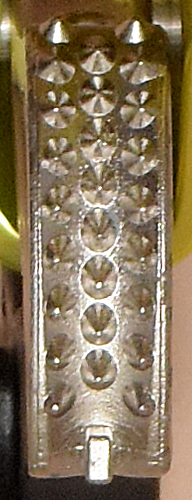 The ascender shell is a 4.0 mm. thick subtriangular orange anodized aluminum
stamping. The rope channel is formed by bending
the right side of the ascender into a U. The rope channel
is 16 mm. wide. The main sling attachment point
is located below the cam and behind the rope channel. A second
attachment point is located above the cam and also behind the
rope channel. The shell is bent backwards at both points to provide
clearance between the attachment slings and the main rope. This
accounts for the rather large thickness of this ascender. The
attachment points appear to be circles distorted by the stamping
and bending operation. The lower attachment point measures 16.0 mm. wide by 17.0 mm. high and the upper 14.3 by 14.6 mm. The left
end of the shell is bent on an inclined axis to form another U.
A hole drilled through both sides of the U accepts a semi-tubular rivet.
The cam, cam spring, and a spacer washer are mounted on this rivet.
The head of the rivet is in the front, while the roll is in the
rear. The hole in the roll is nearly s deep as the shell is thick.
The pivot is centered 46 mm. from the inside of the rope
groove. There is a stamped stop above
the cam.
The ascender shell is a 4.0 mm. thick subtriangular orange anodized aluminum
stamping. The rope channel is formed by bending
the right side of the ascender into a U. The rope channel
is 16 mm. wide. The main sling attachment point
is located below the cam and behind the rope channel. A second
attachment point is located above the cam and also behind the
rope channel. The shell is bent backwards at both points to provide
clearance between the attachment slings and the main rope. This
accounts for the rather large thickness of this ascender. The
attachment points appear to be circles distorted by the stamping
and bending operation. The lower attachment point measures 16.0 mm. wide by 17.0 mm. high and the upper 14.3 by 14.6 mm. The left
end of the shell is bent on an inclined axis to form another U.
A hole drilled through both sides of the U accepts a semi-tubular rivet.
The cam, cam spring, and a spacer washer are mounted on this rivet.
The head of the rivet is in the front, while the roll is in the
rear. The hole in the roll is nearly s deep as the shell is thick.
The pivot is centered 46 mm. from the inside of the rope
groove. There is a stamped stop above
the cam.
The cam is a plated skeletonized steel casting. The cam radius increases from 33 to 53 mm. over an angle of 45°, giving a 31° cam angle. The cam has number
of small conical teeth, all of which have their axes approximately
perpendicular to the cam face. The tooth pattern is (2)(1.2)^8(B).
The B stands for a small bar. A plastic spring-loaded manual safety is
mounted on an axle riveted to the bottom center of the
cam. The normal action of the spring holds the safety against
the cam.When the cam is opened, the
shell interferes with the safety, thus preventing cam opening.
At full open the safety can be released and the spring will hold
the tab against the back of the shell, locking the cam open.
The rear is printed with "D42,"
"Sync Ascender," the heightec logo," "heightec," "•Ø10-13 mm," a standing man icon, "↑," a book-with-an-"i" icon, "100kg," "CE0598, "UKCA", "0120," "EN567:2013," "EN12841B:2006," and "121121." It is stamped with "D3291."
|
 |
Warning:
The weight ("100kg") printed on the shell can easily be
less than the weight of a fully loaded caver. |
 |
|
The Twist is solidly made. All sharp edges have been
removed. The attachment points are simply holes in the shell,
and although rounded they should have been beveled more; even
so, I would consider their small radius too sharp for directly
attaching rope slings.
The safety is awkward to use with one hand when the ascender is not constrained by a harness. The cam and its teeth are very well made. I'm not
sure what purpose the bar serves - several people have sent me
emails telling me that the analogous bars on the Lucky
AB-20 and VauDe AB-20 Bloquer keep
the cam from closing and touching the shell (so what?), but the
bar does not do touch the shell on the D42. Perhaps it is there
to keep the ascender from gripping small cord?? It certainly keeps
the lower teeth from working effectively.
[ Top
| Sync D44
| Twist D42
| Twist D42 v. B
| Return to E.C. Ascenders
]
heightec-PMI Twist D42A
Version A
(#268, 2140)
Technical Details
I acquired my heightec-PMI Twist D42A from On Rope 1 in 2009. I acquired another in 2017 as part of Bob Thrun’s collection.
The heightec-PMI Twist D42A is 107 mm. tall, 71 mm.
wide, 31 mm. thick, and weighs 142 g.
Like most chest ascenders,
this one is left-handed. 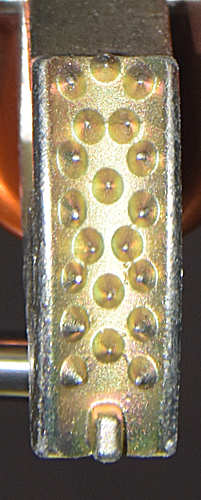 The ascender shell is a 3.8 mm. thick subtriangular orange anodized aluminum stamping. The rope channel is formed by bending
the right side of the ascender into a U. The rope channel
is 15.8 mm. wide. The main sling attachment point
is located below the cam and behind the rope channel. A second
attachment point is located above the cam and also behind the
rope channel. The shell is bent backwards at both points to provide
clearance between the attachment slings and the main rope. This
accounts for the rather large thickness of this ascender. The
attachment points appear to be circles distorted by the stamping
and bending operation. The lower attachment point measures 17.5
by 16.5 mm. and the upper 16.6 by 13.7 mm. The left
end of the shell is bent on an inclined axis to form another U.
A hole drilled through both sides of the U accepts a semi-tubular rivet.
The cam, cam spring, and a spacer washer are mounted on this rivet.
The head of the rivet is in the front, while the roll is in the
rear. The hole in the roll is nearly s deep as the shell is thick.
The pivot is centered 47 mm. from the inside of the rope
groove. There is a cylindrical cam stop riveted to the shell above
the cam.
The ascender shell is a 3.8 mm. thick subtriangular orange anodized aluminum stamping. The rope channel is formed by bending
the right side of the ascender into a U. The rope channel
is 15.8 mm. wide. The main sling attachment point
is located below the cam and behind the rope channel. A second
attachment point is located above the cam and also behind the
rope channel. The shell is bent backwards at both points to provide
clearance between the attachment slings and the main rope. This
accounts for the rather large thickness of this ascender. The
attachment points appear to be circles distorted by the stamping
and bending operation. The lower attachment point measures 17.5
by 16.5 mm. and the upper 16.6 by 13.7 mm. The left
end of the shell is bent on an inclined axis to form another U.
A hole drilled through both sides of the U accepts a semi-tubular rivet.
The cam, cam spring, and a spacer washer are mounted on this rivet.
The head of the rivet is in the front, while the roll is in the
rear. The hole in the roll is nearly s deep as the shell is thick.
The pivot is centered 47 mm. from the inside of the rope
groove. There is a cylindrical cam stop riveted to the shell above
the cam.
The cam is a plated skeletonized steel casting. The cam radius,
measured from the pivot, increases from 38 to 52 mm. over
an angle of 37°, giving a 26° cam angle. The cam has number
of small conical teeth, all of which have their axes approximately
perpendicular to the cam face. The tooth pattern is (1.2^3)^2(1.2)^2(B).
The B stands for a small bar. A spring-loaded manual safety is
mounted on an axle riveted to the bottom center of the
cam. The normal action of the spring holds the safety against
the cam. The safety has a 12.8 mm. tall, 6 mm. diameter
pin mounted on it for the fingers. When the cam is opened, the
shell interferes with the safety, thus preventing cam opening.
At full open the safety can be released and the spring will hold
the tab against the back of the shell, locking the cam open.
The rear of the ascender is printed with a book-with-an-"i" icon, "D42A," "Ø8-13," "heightec-PMI," "www.heightec.com,"
and "1008 038."
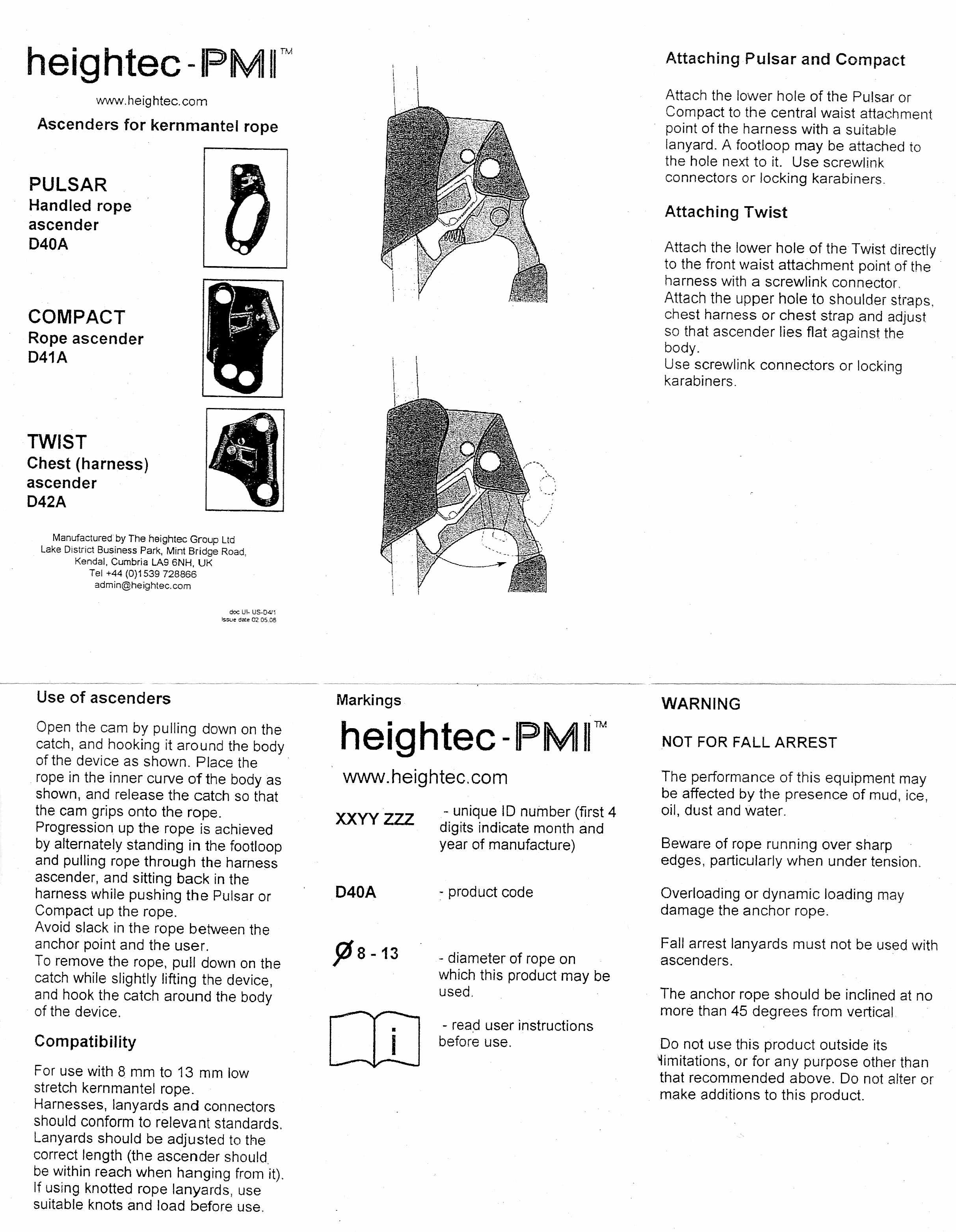 The heightec-PMI is solidly made. All sharp edges have been
removed. The attachment points are simply holes in the shell,
and although rounded they should have been beveled more; even
so, I would consider their small radius too sharp for directly
attaching rope slings. The cam is the same as the cam on the other
heightec-PMI ascenders (Pulsar
D40, Compact D41A, and Rescue
Compact D41A/ D44 Rope Grab/ D44A).
The heightec-PMI is solidly made. All sharp edges have been
removed. The attachment points are simply holes in the shell,
and although rounded they should have been beveled more; even
so, I would consider their small radius too sharp for directly
attaching rope slings. The cam is the same as the cam on the other
heightec-PMI ascenders (Pulsar
D40, Compact D41A, and Rescue
Compact D41A/ D44 Rope Grab/ D44A).
The cam stop is completely superfluous: the cam does not touch
the cam stop, even when the ascender is off rope.
The safety is awkward to use with one hand (like the Petzl
Basic). The cam and its teeth are very well made. I'm not
sure what purpose the bar serves - several people have sent me
emails telling me that the analogous bars on the Lucky
AB-20 and VauDe AB-20 Bloquer keep
the cam from closing and touching the shell (so what?), but the
bar does not do touch the shell on the D42A. Perhaps it is there
to keep the ascender from gripping small cord?? It certainly keeps
the lower teeth from working effectively.
A major problem with mine is that the cam rubs against
the cam axle channel whenever one tries to open the cam fully.
This causes the cam to grate as I open or close it. I actually
feel - and hear - a pronounced "click" as the cam binds
and breaks free. Mine is definitely NOT a smooth-operating ascender.
At present, there are better chest ascenders on the market
that sell for a similar price.
[ Top
| Sync D44
| Twist D42
| Twist D42 v. A
| Return to E.C. Ascenders
]
heightec-PMI Twist D42A
Version B
(#1502, 2141)
Technical Details
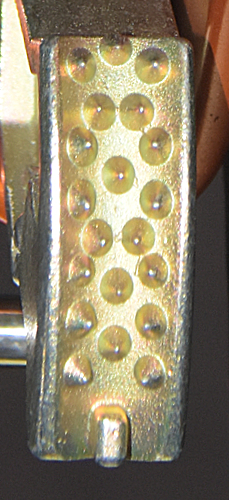 I acquired my heightec-PMI Twist D42A, Version B from On Rope 1 in 2009. I acquired another in 2017 as part of Bob Thrun’s collection.
I acquired my heightec-PMI Twist D42A, Version B from On Rope 1 in 2009. I acquired another in 2017 as part of Bob Thrun’s collection.
Version B is 103 mm. tall, 73 mm. wide, 38 mm. thick, and weighs 145 g. The only significant difference between Versions A and B is that Version B has a plastic safety.
The rear of the ascender is printed with a book-with-an-"i" icon, "D42A," "•Ø8-13," "heightec-PMI," "www.heightec.com,"
and "1108 092."
The new safety is also awkward to use; perhaps even more so than the one on Version A.
[ Top
| Sync D44
| Twist D42
| Twist D42 v. A
| Twist D42 v. B
]



